Innovations and Advancements in the Electricity Sector Report
VerifiedAdded on 2022/10/17
|15
|2703
|18
Report
AI Summary
This report provides a comprehensive overview of five significant innovations and advancements in the electricity sector: smart grids, HVDC (High Voltage Direct Current) technology, dynamic line rating, and superconducting magnetic energy storage (SMES). For each innovation, the report defines the technology, outlines its benefits to the electrical industry, explains its operational principles, and identifies the challenges associated with its implementation. The analysis includes discussions on how smart grids enhance power distribution and communication, the environmental and efficiency advantages of HVDC transmission, the role of dynamic line rating in optimizing conductor capacity, and the operational and efficiency benefits of SMES. Challenges such as the need for infrastructure upgrades, regulatory hurdles, and high initial costs are also discussed. Supporting figures, data, and references are included to provide a detailed understanding of each technology and its impact on the future of the electricity sector.

University
Innovations and Advancements in the Electricity Sector
By
Your Name
Date
Page 1 of 15
Innovations and Advancements in the Electricity Sector
By
Your Name
Date
Page 1 of 15
Paraphrase This Document
Need a fresh take? Get an instant paraphrase of this document with our AI Paraphraser
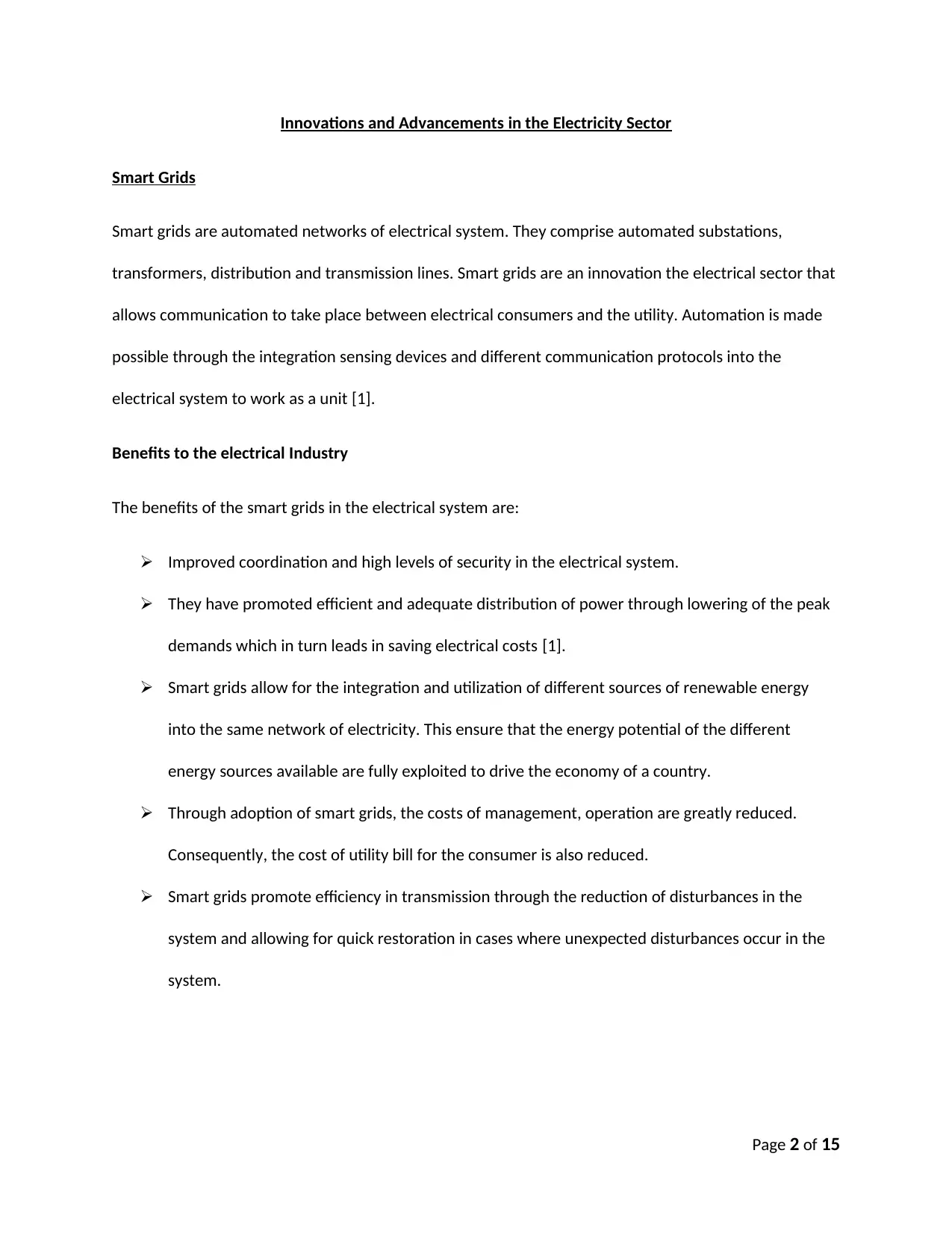
Innovations and Advancements in the Electricity Sector
Smart Grids
Smart grids are automated networks of electrical system. They comprise automated substations,
transformers, distribution and transmission lines. Smart grids are an innovation the electrical sector that
allows communication to take place between electrical consumers and the utility. Automation is made
possible through the integration sensing devices and different communication protocols into the
electrical system to work as a unit [1].
Benefits to the electrical Industry
The benefits of the smart grids in the electrical system are:
Improved coordination and high levels of security in the electrical system.
They have promoted efficient and adequate distribution of power through lowering of the peak
demands which in turn leads in saving electrical costs [1].
Smart grids allow for the integration and utilization of different sources of renewable energy
into the same network of electricity. This ensure that the energy potential of the different
energy sources available are fully exploited to drive the economy of a country.
Through adoption of smart grids, the costs of management, operation are greatly reduced.
Consequently, the cost of utility bill for the consumer is also reduced.
Smart grids promote efficiency in transmission through the reduction of disturbances in the
system and allowing for quick restoration in cases where unexpected disturbances occur in the
system.
Page 2 of 15
Smart Grids
Smart grids are automated networks of electrical system. They comprise automated substations,
transformers, distribution and transmission lines. Smart grids are an innovation the electrical sector that
allows communication to take place between electrical consumers and the utility. Automation is made
possible through the integration sensing devices and different communication protocols into the
electrical system to work as a unit [1].
Benefits to the electrical Industry
The benefits of the smart grids in the electrical system are:
Improved coordination and high levels of security in the electrical system.
They have promoted efficient and adequate distribution of power through lowering of the peak
demands which in turn leads in saving electrical costs [1].
Smart grids allow for the integration and utilization of different sources of renewable energy
into the same network of electricity. This ensure that the energy potential of the different
energy sources available are fully exploited to drive the economy of a country.
Through adoption of smart grids, the costs of management, operation are greatly reduced.
Consequently, the cost of utility bill for the consumer is also reduced.
Smart grids promote efficiency in transmission through the reduction of disturbances in the
system and allowing for quick restoration in cases where unexpected disturbances occur in the
system.
Page 2 of 15
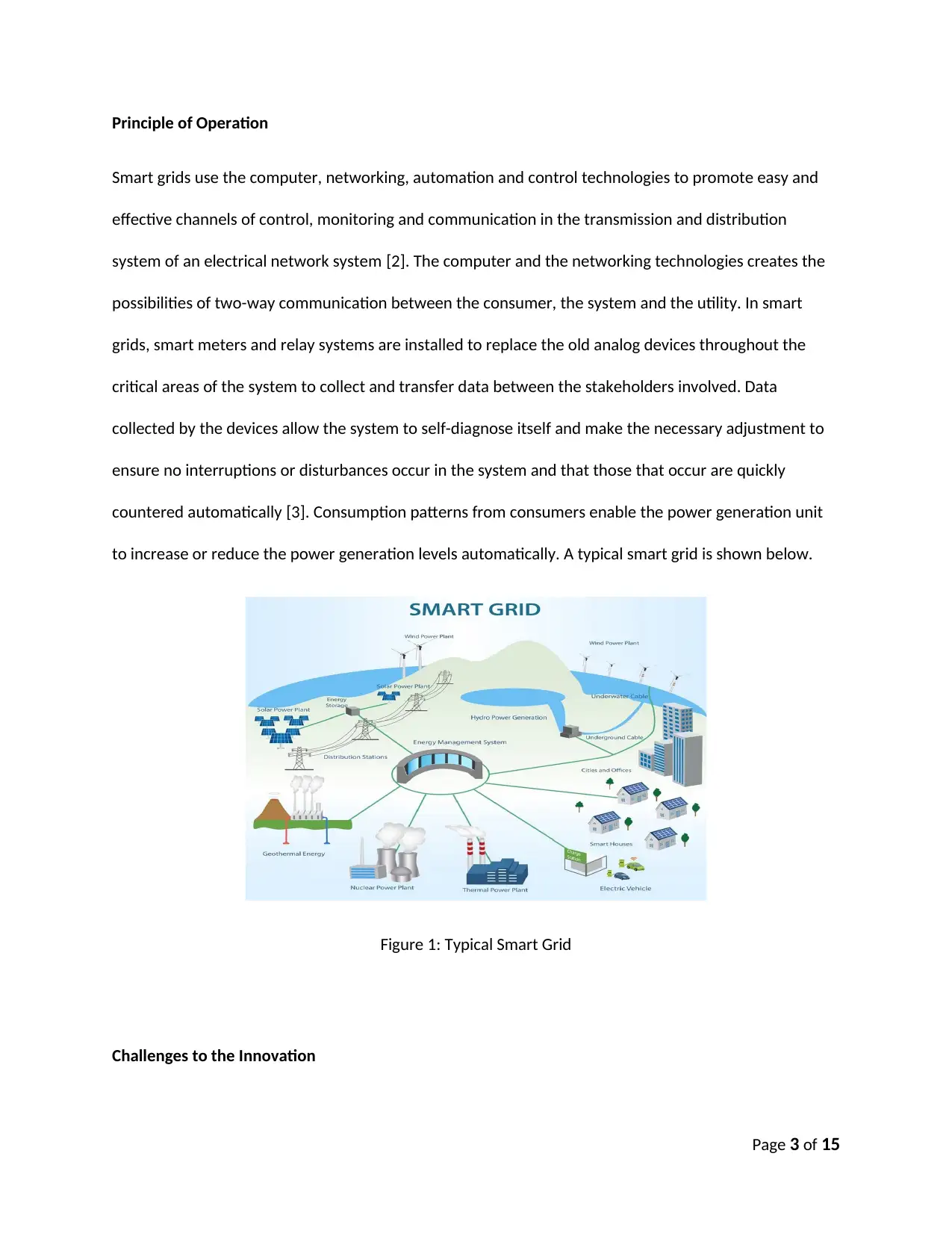
Principle of Operation
Smart grids use the computer, networking, automation and control technologies to promote easy and
effective channels of control, monitoring and communication in the transmission and distribution
system of an electrical network system [2]. The computer and the networking technologies creates the
possibilities of two-way communication between the consumer, the system and the utility. In smart
grids, smart meters and relay systems are installed to replace the old analog devices throughout the
critical areas of the system to collect and transfer data between the stakeholders involved. Data
collected by the devices allow the system to self-diagnose itself and make the necessary adjustment to
ensure no interruptions or disturbances occur in the system and that those that occur are quickly
countered automatically [3]. Consumption patterns from consumers enable the power generation unit
to increase or reduce the power generation levels automatically. A typical smart grid is shown below.
Figure 1: Typical Smart Grid
Challenges to the Innovation
Page 3 of 15
Smart grids use the computer, networking, automation and control technologies to promote easy and
effective channels of control, monitoring and communication in the transmission and distribution
system of an electrical network system [2]. The computer and the networking technologies creates the
possibilities of two-way communication between the consumer, the system and the utility. In smart
grids, smart meters and relay systems are installed to replace the old analog devices throughout the
critical areas of the system to collect and transfer data between the stakeholders involved. Data
collected by the devices allow the system to self-diagnose itself and make the necessary adjustment to
ensure no interruptions or disturbances occur in the system and that those that occur are quickly
countered automatically [3]. Consumption patterns from consumers enable the power generation unit
to increase or reduce the power generation levels automatically. A typical smart grid is shown below.
Figure 1: Typical Smart Grid
Challenges to the Innovation
Page 3 of 15
⊘ This is a preview!⊘
Do you want full access?
Subscribe today to unlock all pages.

Trusted by 1+ million students worldwide

The challenges facing the smart grid technology are:
Stakeholders lack of awareness on the standards, the regulatory guidelines and the best
practices of designing and operating the smart grids [2].
Technical problems that result from the complexity of most electrical networks that have been
in existence over years making it difficult to decide where system intelligence is necessary [4].
Adoption of the smart grid technology is limited by the high cost of setting up the infrastructure.
HVDC Technology
HVDC is a technology that involves bulk transmission of electricity over long distances in the direct
current form. The transmission can be done through high voltage direct current overhead lines,
underground cables or submarine cables. Moreover, the system is used as a link between different
sections of a power system that do not allow the use of alternating current [5]. High voltage direct
transmission can either be a point-to-point transmission, multi-terminal transmission system or back-to-
back transmission systems. The rating of a HVDC network ranges between 1000MW and 3000MW.
Benefits to the electrical Industry
The benefits of the high voltage direct current (HVDC) transmission are:
Its more environmentally friendly compared to the high voltage alternating transmission.
Short circuit currents in the HVDC transmission are frequent and enormous as it is the case with
alternating high voltage transmission.
Control, monitoring and diagnosis of a dc network is much easier compared to ac network. The
HVDC network also allows asynchronous connections.
Page 4 of 15
Stakeholders lack of awareness on the standards, the regulatory guidelines and the best
practices of designing and operating the smart grids [2].
Technical problems that result from the complexity of most electrical networks that have been
in existence over years making it difficult to decide where system intelligence is necessary [4].
Adoption of the smart grid technology is limited by the high cost of setting up the infrastructure.
HVDC Technology
HVDC is a technology that involves bulk transmission of electricity over long distances in the direct
current form. The transmission can be done through high voltage direct current overhead lines,
underground cables or submarine cables. Moreover, the system is used as a link between different
sections of a power system that do not allow the use of alternating current [5]. High voltage direct
transmission can either be a point-to-point transmission, multi-terminal transmission system or back-to-
back transmission systems. The rating of a HVDC network ranges between 1000MW and 3000MW.
Benefits to the electrical Industry
The benefits of the high voltage direct current (HVDC) transmission are:
Its more environmentally friendly compared to the high voltage alternating transmission.
Short circuit currents in the HVDC transmission are frequent and enormous as it is the case with
alternating high voltage transmission.
Control, monitoring and diagnosis of a dc network is much easier compared to ac network. The
HVDC network also allows asynchronous connections.
Page 4 of 15
Paraphrase This Document
Need a fresh take? Get an instant paraphrase of this document with our AI Paraphraser
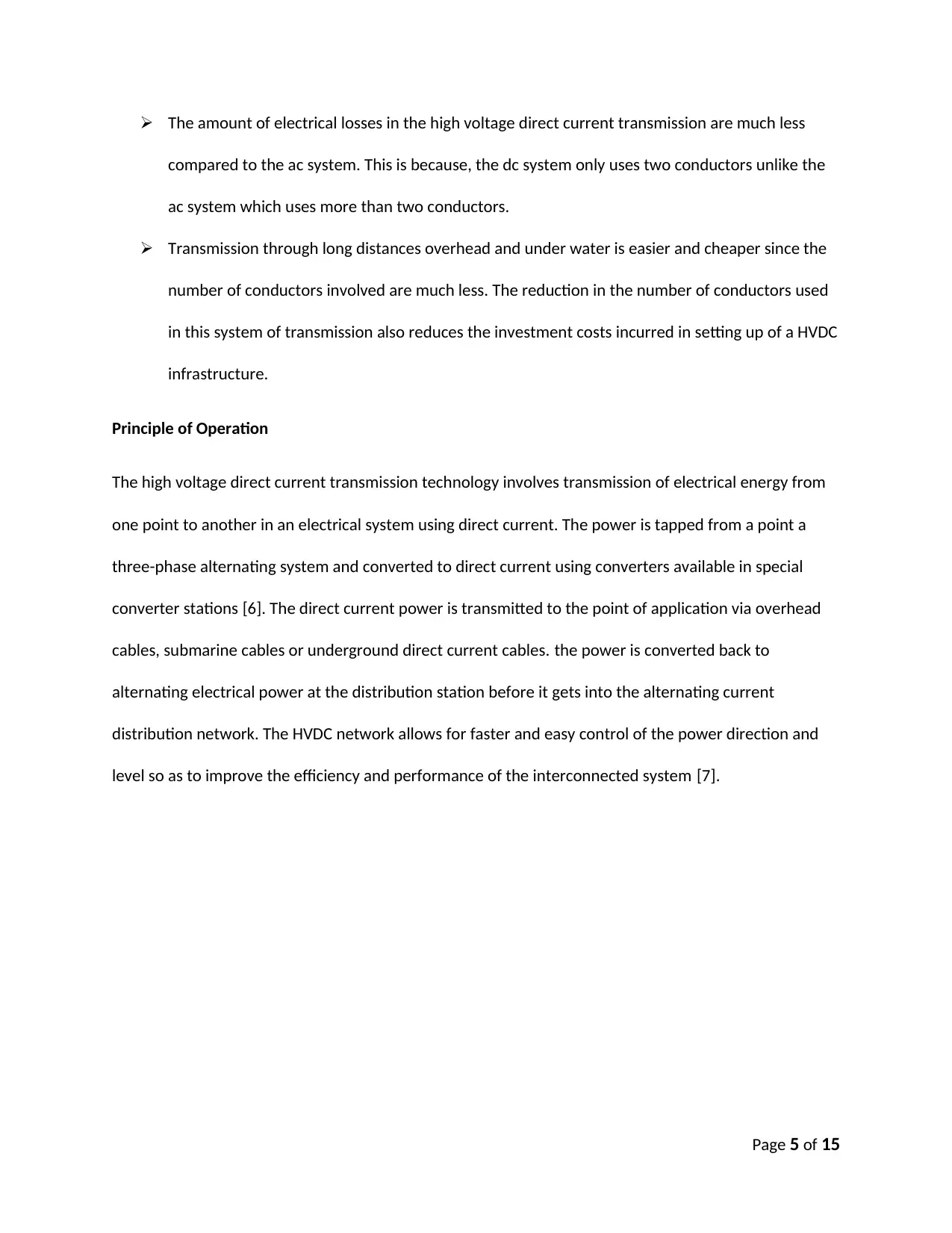
The amount of electrical losses in the high voltage direct current transmission are much less
compared to the ac system. This is because, the dc system only uses two conductors unlike the
ac system which uses more than two conductors.
Transmission through long distances overhead and under water is easier and cheaper since the
number of conductors involved are much less. The reduction in the number of conductors used
in this system of transmission also reduces the investment costs incurred in setting up of a HVDC
infrastructure.
Principle of Operation
The high voltage direct current transmission technology involves transmission of electrical energy from
one point to another in an electrical system using direct current. The power is tapped from a point a
three-phase alternating system and converted to direct current using converters available in special
converter stations [6]. The direct current power is transmitted to the point of application via overhead
cables, submarine cables or underground direct current cables. the power is converted back to
alternating electrical power at the distribution station before it gets into the alternating current
distribution network. The HVDC network allows for faster and easy control of the power direction and
level so as to improve the efficiency and performance of the interconnected system [7].
Page 5 of 15
compared to the ac system. This is because, the dc system only uses two conductors unlike the
ac system which uses more than two conductors.
Transmission through long distances overhead and under water is easier and cheaper since the
number of conductors involved are much less. The reduction in the number of conductors used
in this system of transmission also reduces the investment costs incurred in setting up of a HVDC
infrastructure.
Principle of Operation
The high voltage direct current transmission technology involves transmission of electrical energy from
one point to another in an electrical system using direct current. The power is tapped from a point a
three-phase alternating system and converted to direct current using converters available in special
converter stations [6]. The direct current power is transmitted to the point of application via overhead
cables, submarine cables or underground direct current cables. the power is converted back to
alternating electrical power at the distribution station before it gets into the alternating current
distribution network. The HVDC network allows for faster and easy control of the power direction and
level so as to improve the efficiency and performance of the interconnected system [7].
Page 5 of 15
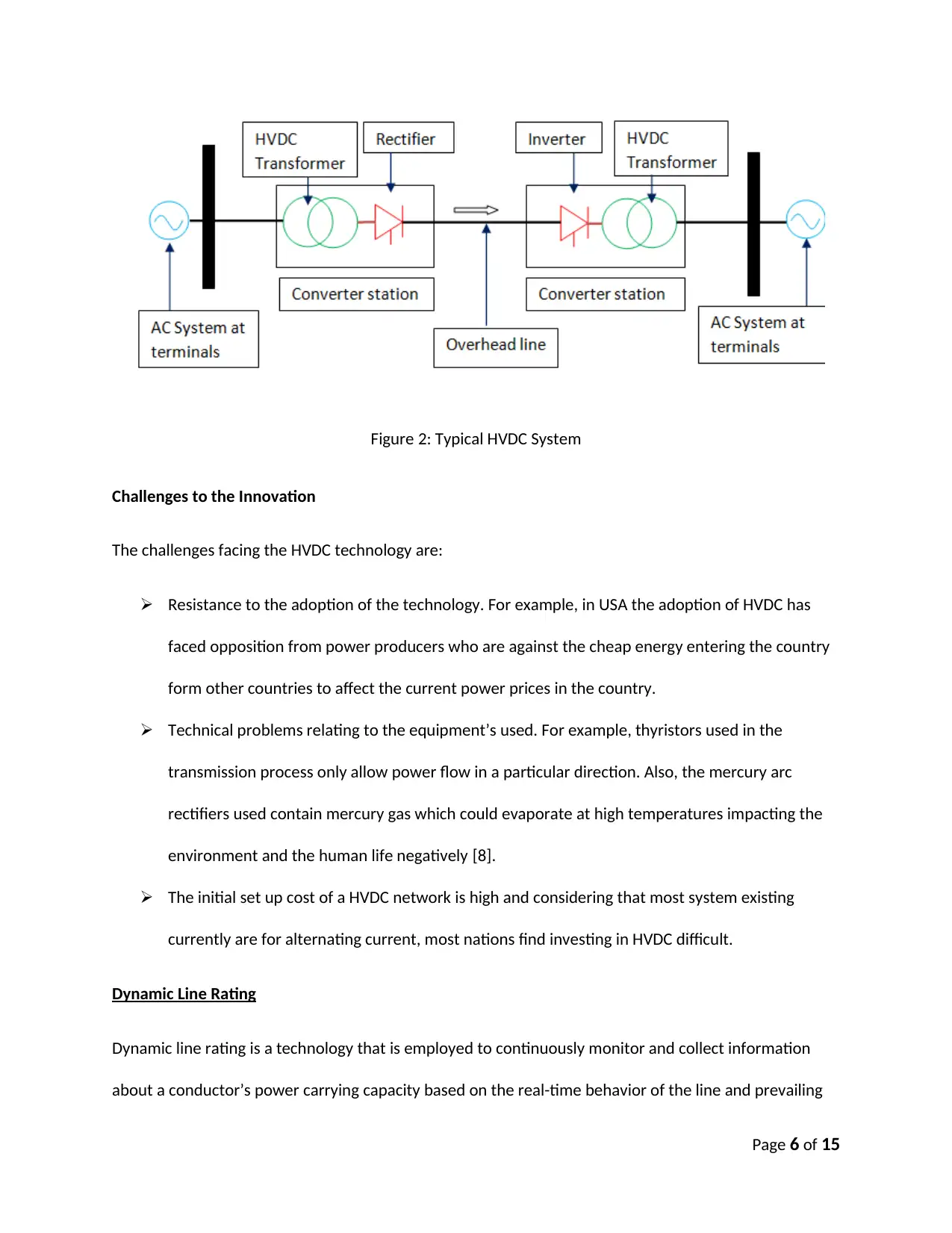
Figure 2: Typical HVDC System
Challenges to the Innovation
The challenges facing the HVDC technology are:
Resistance to the adoption of the technology. For example, in USA the adoption of HVDC has
faced opposition from power producers who are against the cheap energy entering the country
form other countries to affect the current power prices in the country.
Technical problems relating to the equipment’s used. For example, thyristors used in the
transmission process only allow power flow in a particular direction. Also, the mercury arc
rectifiers used contain mercury gas which could evaporate at high temperatures impacting the
environment and the human life negatively [8].
The initial set up cost of a HVDC network is high and considering that most system existing
currently are for alternating current, most nations find investing in HVDC difficult.
Dynamic Line Rating
Dynamic line rating is a technology that is employed to continuously monitor and collect information
about a conductor’s power carrying capacity based on the real-time behavior of the line and prevailing
Page 6 of 15
Challenges to the Innovation
The challenges facing the HVDC technology are:
Resistance to the adoption of the technology. For example, in USA the adoption of HVDC has
faced opposition from power producers who are against the cheap energy entering the country
form other countries to affect the current power prices in the country.
Technical problems relating to the equipment’s used. For example, thyristors used in the
transmission process only allow power flow in a particular direction. Also, the mercury arc
rectifiers used contain mercury gas which could evaporate at high temperatures impacting the
environment and the human life negatively [8].
The initial set up cost of a HVDC network is high and considering that most system existing
currently are for alternating current, most nations find investing in HVDC difficult.
Dynamic Line Rating
Dynamic line rating is a technology that is employed to continuously monitor and collect information
about a conductor’s power carrying capacity based on the real-time behavior of the line and prevailing
Page 6 of 15
⊘ This is a preview!⊘
Do you want full access?
Subscribe today to unlock all pages.

Trusted by 1+ million students worldwide
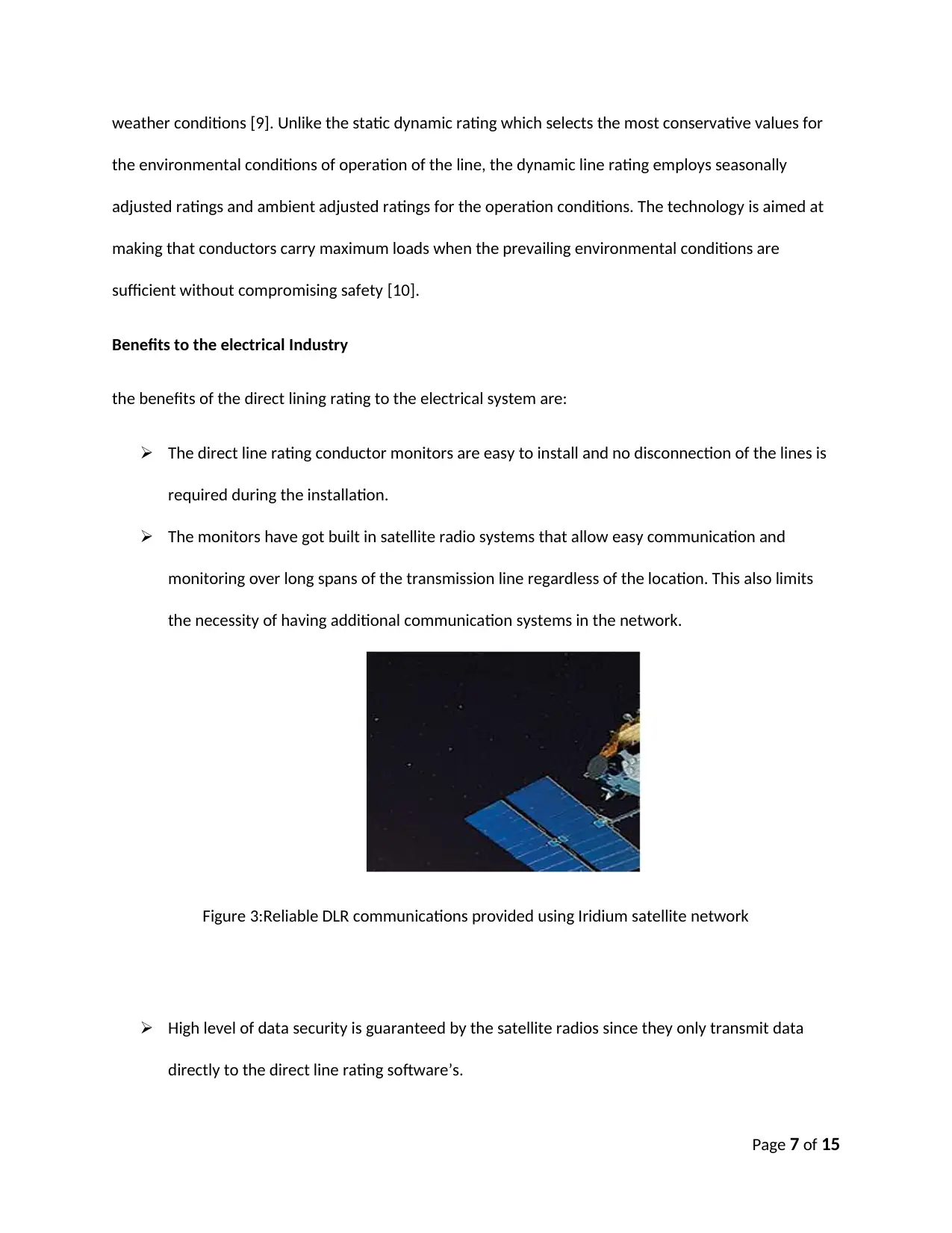
weather conditions [9]. Unlike the static dynamic rating which selects the most conservative values for
the environmental conditions of operation of the line, the dynamic line rating employs seasonally
adjusted ratings and ambient adjusted ratings for the operation conditions. The technology is aimed at
making that conductors carry maximum loads when the prevailing environmental conditions are
sufficient without compromising safety [10].
Benefits to the electrical Industry
the benefits of the direct lining rating to the electrical system are:
The direct line rating conductor monitors are easy to install and no disconnection of the lines is
required during the installation.
The monitors have got built in satellite radio systems that allow easy communication and
monitoring over long spans of the transmission line regardless of the location. This also limits
the necessity of having additional communication systems in the network.
Figure 3:Reliable DLR communications provided using Iridium satellite network
High level of data security is guaranteed by the satellite radios since they only transmit data
directly to the direct line rating software’s.
Page 7 of 15
the environmental conditions of operation of the line, the dynamic line rating employs seasonally
adjusted ratings and ambient adjusted ratings for the operation conditions. The technology is aimed at
making that conductors carry maximum loads when the prevailing environmental conditions are
sufficient without compromising safety [10].
Benefits to the electrical Industry
the benefits of the direct lining rating to the electrical system are:
The direct line rating conductor monitors are easy to install and no disconnection of the lines is
required during the installation.
The monitors have got built in satellite radio systems that allow easy communication and
monitoring over long spans of the transmission line regardless of the location. This also limits
the necessity of having additional communication systems in the network.
Figure 3:Reliable DLR communications provided using Iridium satellite network
High level of data security is guaranteed by the satellite radios since they only transmit data
directly to the direct line rating software’s.
Page 7 of 15
Paraphrase This Document
Need a fresh take? Get an instant paraphrase of this document with our AI Paraphraser
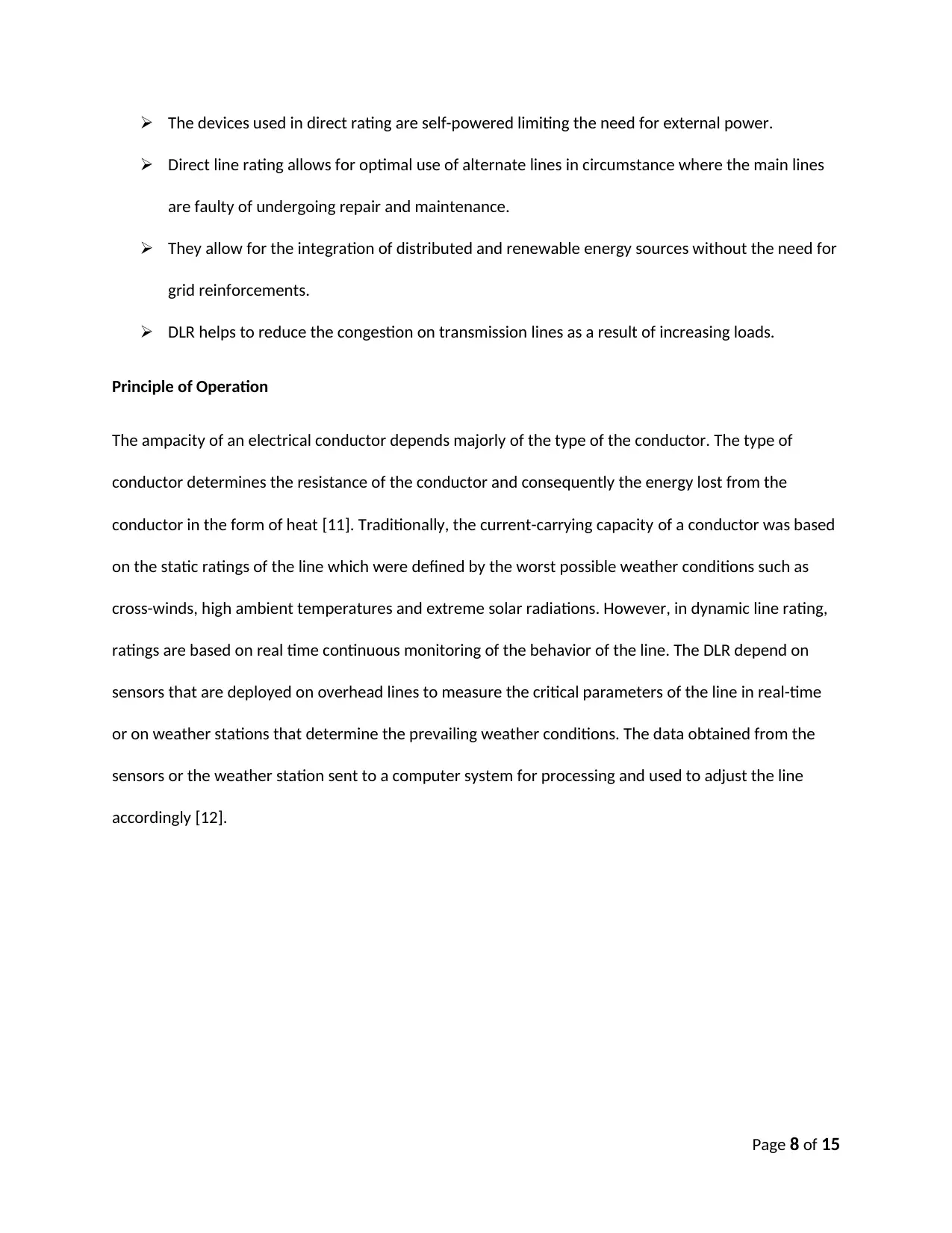
The devices used in direct rating are self-powered limiting the need for external power.
Direct line rating allows for optimal use of alternate lines in circumstance where the main lines
are faulty of undergoing repair and maintenance.
They allow for the integration of distributed and renewable energy sources without the need for
grid reinforcements.
DLR helps to reduce the congestion on transmission lines as a result of increasing loads.
Principle of Operation
The ampacity of an electrical conductor depends majorly of the type of the conductor. The type of
conductor determines the resistance of the conductor and consequently the energy lost from the
conductor in the form of heat [11]. Traditionally, the current-carrying capacity of a conductor was based
on the static ratings of the line which were defined by the worst possible weather conditions such as
cross-winds, high ambient temperatures and extreme solar radiations. However, in dynamic line rating,
ratings are based on real time continuous monitoring of the behavior of the line. The DLR depend on
sensors that are deployed on overhead lines to measure the critical parameters of the line in real-time
or on weather stations that determine the prevailing weather conditions. The data obtained from the
sensors or the weather station sent to a computer system for processing and used to adjust the line
accordingly [12].
Page 8 of 15
Direct line rating allows for optimal use of alternate lines in circumstance where the main lines
are faulty of undergoing repair and maintenance.
They allow for the integration of distributed and renewable energy sources without the need for
grid reinforcements.
DLR helps to reduce the congestion on transmission lines as a result of increasing loads.
Principle of Operation
The ampacity of an electrical conductor depends majorly of the type of the conductor. The type of
conductor determines the resistance of the conductor and consequently the energy lost from the
conductor in the form of heat [11]. Traditionally, the current-carrying capacity of a conductor was based
on the static ratings of the line which were defined by the worst possible weather conditions such as
cross-winds, high ambient temperatures and extreme solar radiations. However, in dynamic line rating,
ratings are based on real time continuous monitoring of the behavior of the line. The DLR depend on
sensors that are deployed on overhead lines to measure the critical parameters of the line in real-time
or on weather stations that determine the prevailing weather conditions. The data obtained from the
sensors or the weather station sent to a computer system for processing and used to adjust the line
accordingly [12].
Page 8 of 15
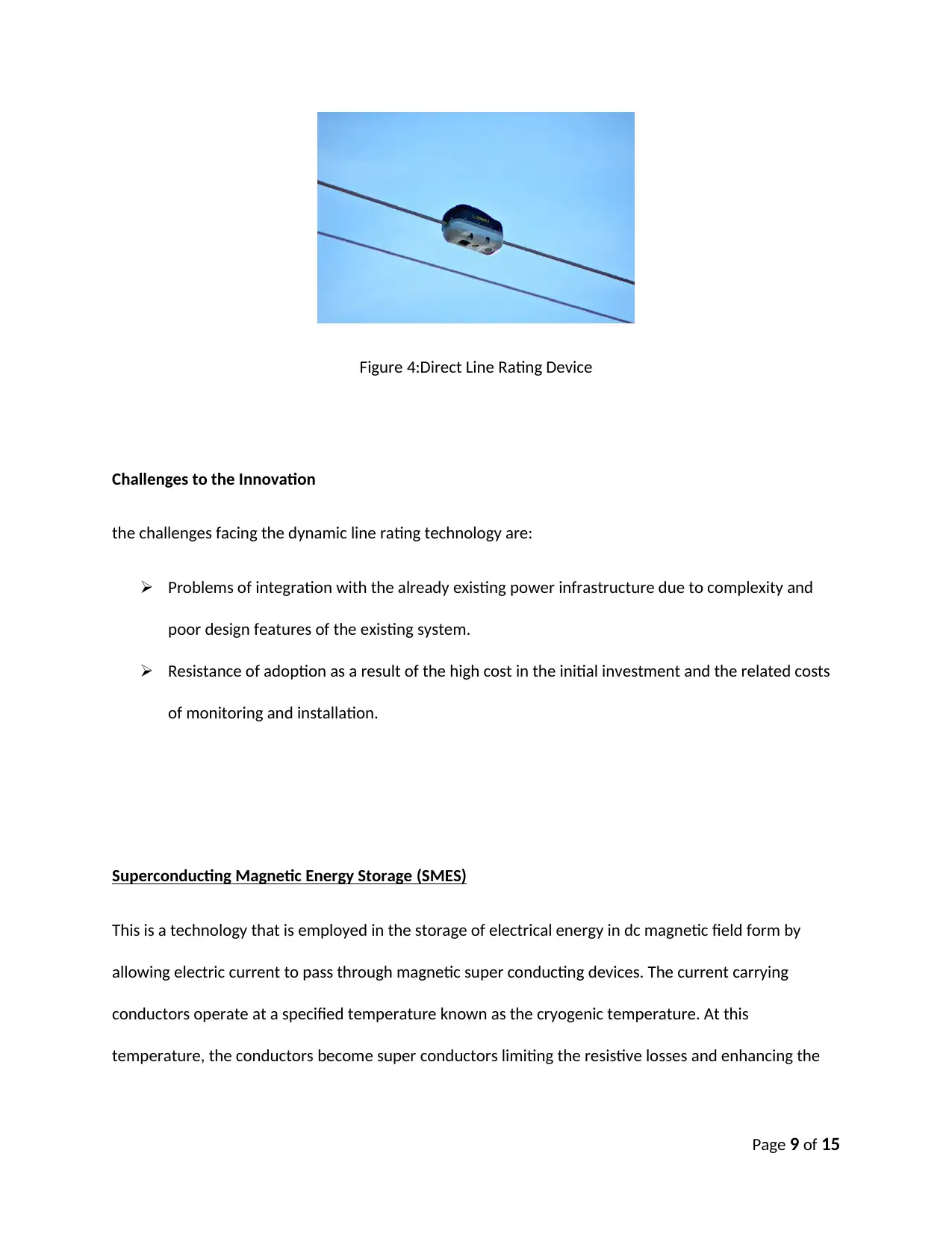
Figure 4:Direct Line Rating Device
Challenges to the Innovation
the challenges facing the dynamic line rating technology are:
Problems of integration with the already existing power infrastructure due to complexity and
poor design features of the existing system.
Resistance of adoption as a result of the high cost in the initial investment and the related costs
of monitoring and installation.
Superconducting Magnetic Energy Storage (SMES)
This is a technology that is employed in the storage of electrical energy in dc magnetic field form by
allowing electric current to pass through magnetic super conducting devices. The current carrying
conductors operate at a specified temperature known as the cryogenic temperature. At this
temperature, the conductors become super conductors limiting the resistive losses and enhancing the
Page 9 of 15
Challenges to the Innovation
the challenges facing the dynamic line rating technology are:
Problems of integration with the already existing power infrastructure due to complexity and
poor design features of the existing system.
Resistance of adoption as a result of the high cost in the initial investment and the related costs
of monitoring and installation.
Superconducting Magnetic Energy Storage (SMES)
This is a technology that is employed in the storage of electrical energy in dc magnetic field form by
allowing electric current to pass through magnetic super conducting devices. The current carrying
conductors operate at a specified temperature known as the cryogenic temperature. At this
temperature, the conductors become super conductors limiting the resistive losses and enhancing the
Page 9 of 15
⊘ This is a preview!⊘
Do you want full access?
Subscribe today to unlock all pages.

Trusted by 1+ million students worldwide
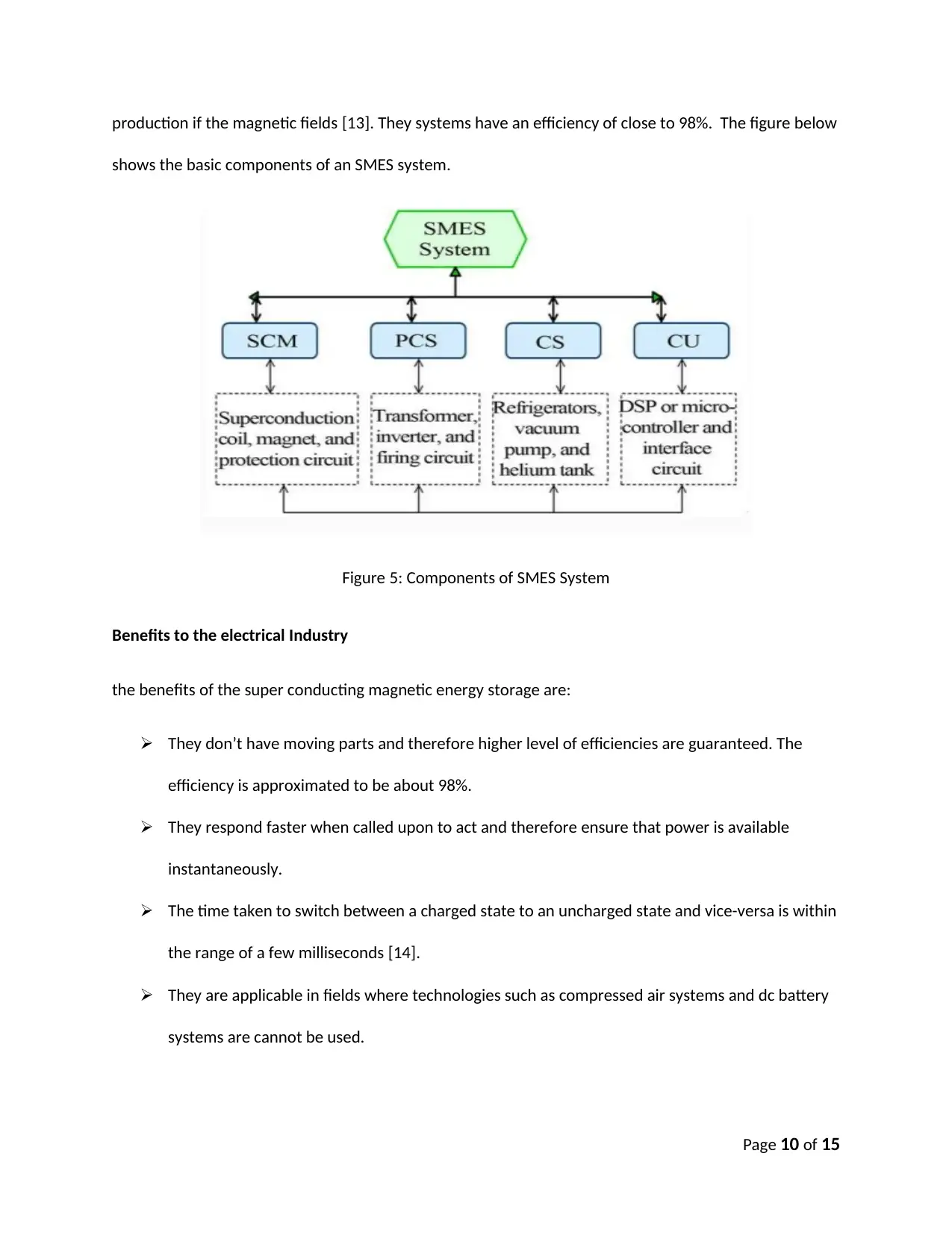
production if the magnetic fields [13]. They systems have an efficiency of close to 98%. The figure below
shows the basic components of an SMES system.
Figure 5: Components of SMES System
Benefits to the electrical Industry
the benefits of the super conducting magnetic energy storage are:
They don’t have moving parts and therefore higher level of efficiencies are guaranteed. The
efficiency is approximated to be about 98%.
They respond faster when called upon to act and therefore ensure that power is available
instantaneously.
The time taken to switch between a charged state to an uncharged state and vice-versa is within
the range of a few milliseconds [14].
They are applicable in fields where technologies such as compressed air systems and dc battery
systems are cannot be used.
Page 10 of 15
shows the basic components of an SMES system.
Figure 5: Components of SMES System
Benefits to the electrical Industry
the benefits of the super conducting magnetic energy storage are:
They don’t have moving parts and therefore higher level of efficiencies are guaranteed. The
efficiency is approximated to be about 98%.
They respond faster when called upon to act and therefore ensure that power is available
instantaneously.
The time taken to switch between a charged state to an uncharged state and vice-versa is within
the range of a few milliseconds [14].
They are applicable in fields where technologies such as compressed air systems and dc battery
systems are cannot be used.
Page 10 of 15
Paraphrase This Document
Need a fresh take? Get an instant paraphrase of this document with our AI Paraphraser
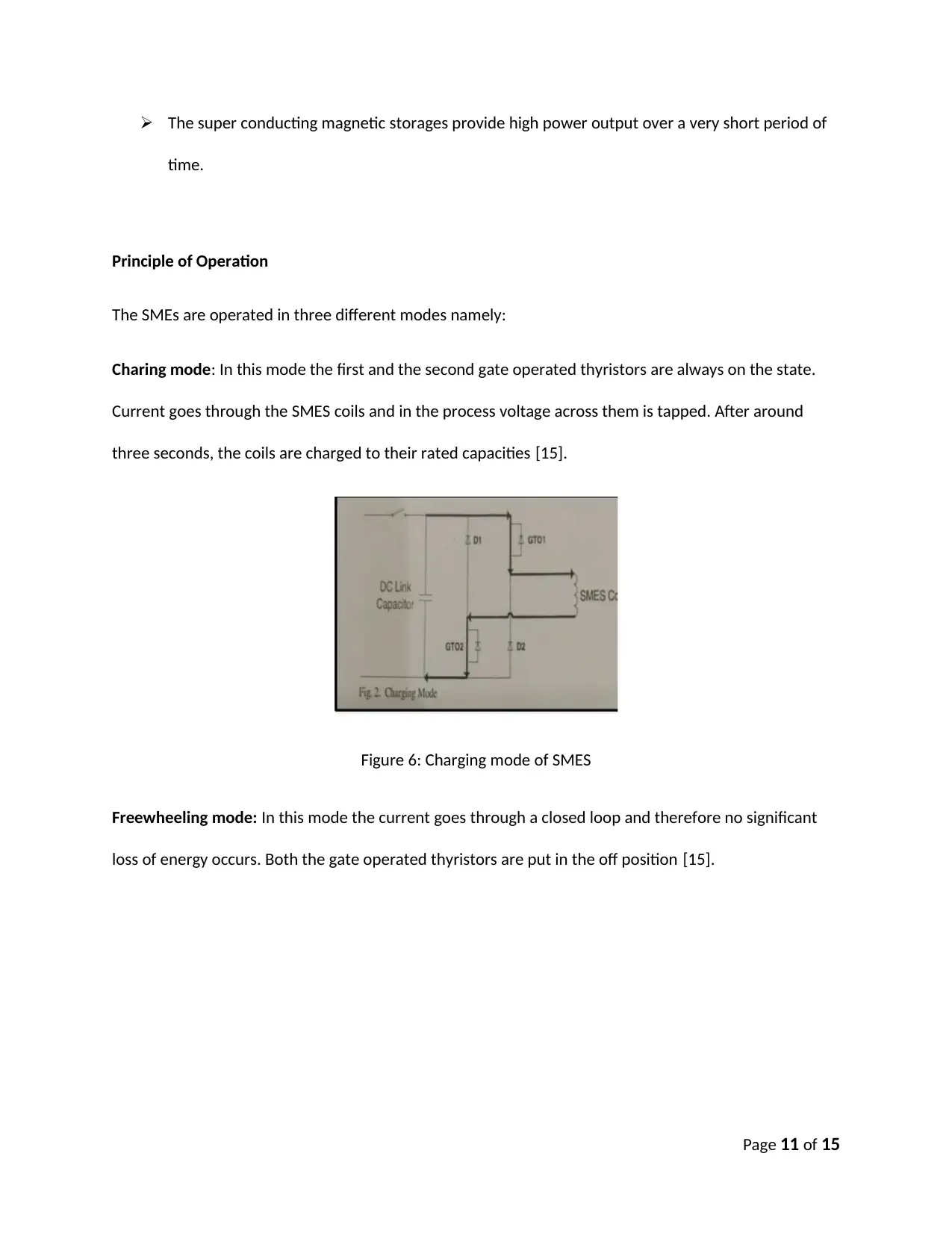
The super conducting magnetic storages provide high power output over a very short period of
time.
Principle of Operation
The SMEs are operated in three different modes namely:
Charing mode: In this mode the first and the second gate operated thyristors are always on the state.
Current goes through the SMES coils and in the process voltage across them is tapped. After around
three seconds, the coils are charged to their rated capacities [15].
Figure 6: Charging mode of SMES
Freewheeling mode: In this mode the current goes through a closed loop and therefore no significant
loss of energy occurs. Both the gate operated thyristors are put in the off position [15].
Page 11 of 15
time.
Principle of Operation
The SMEs are operated in three different modes namely:
Charing mode: In this mode the first and the second gate operated thyristors are always on the state.
Current goes through the SMES coils and in the process voltage across them is tapped. After around
three seconds, the coils are charged to their rated capacities [15].
Figure 6: Charging mode of SMES
Freewheeling mode: In this mode the current goes through a closed loop and therefore no significant
loss of energy occurs. Both the gate operated thyristors are put in the off position [15].
Page 11 of 15
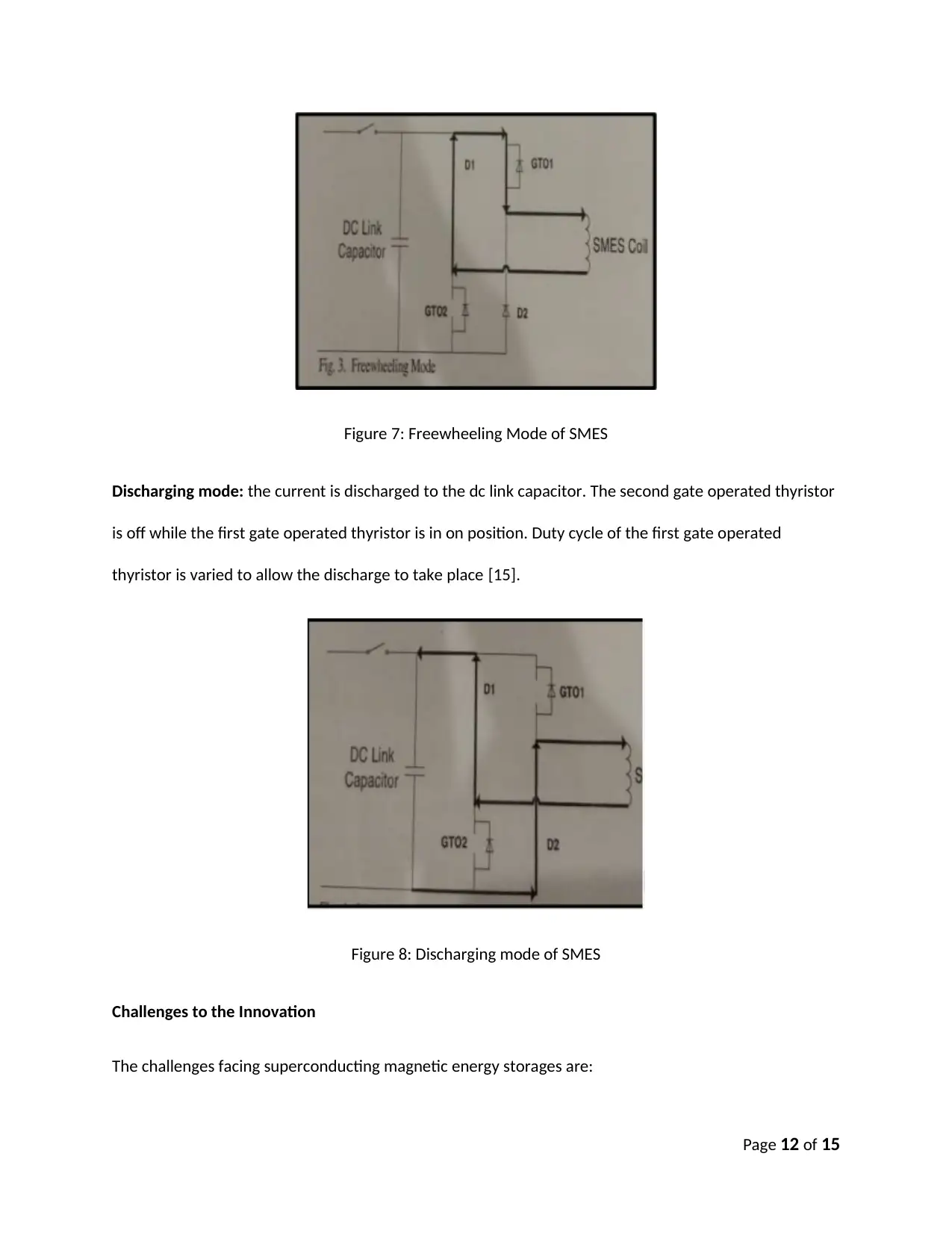
Figure 7: Freewheeling Mode of SMES
Discharging mode: the current is discharged to the dc link capacitor. The second gate operated thyristor
is off while the first gate operated thyristor is in on position. Duty cycle of the first gate operated
thyristor is varied to allow the discharge to take place [15].
Figure 8: Discharging mode of SMES
Challenges to the Innovation
The challenges facing superconducting magnetic energy storages are:
Page 12 of 15
Discharging mode: the current is discharged to the dc link capacitor. The second gate operated thyristor
is off while the first gate operated thyristor is in on position. Duty cycle of the first gate operated
thyristor is varied to allow the discharge to take place [15].
Figure 8: Discharging mode of SMES
Challenges to the Innovation
The challenges facing superconducting magnetic energy storages are:
Page 12 of 15
⊘ This is a preview!⊘
Do you want full access?
Subscribe today to unlock all pages.

Trusted by 1+ million students worldwide
1 out of 15
Related Documents
Your All-in-One AI-Powered Toolkit for Academic Success.
+13062052269
info@desklib.com
Available 24*7 on WhatsApp / Email
![[object Object]](/_next/static/media/star-bottom.7253800d.svg)
Unlock your academic potential
Copyright © 2020–2025 A2Z Services. All Rights Reserved. Developed and managed by ZUCOL.





